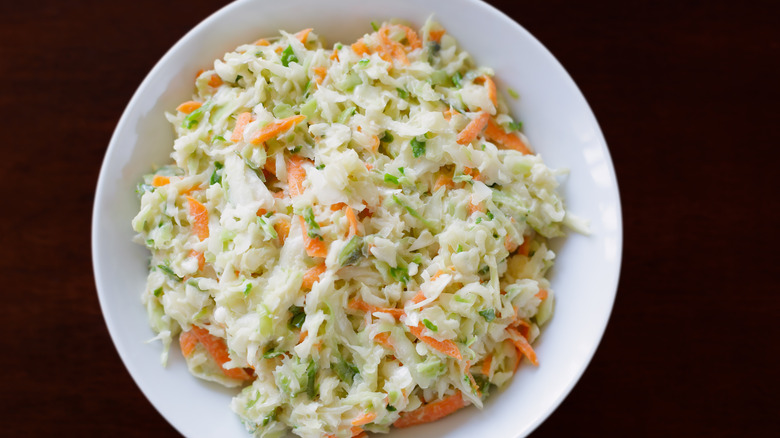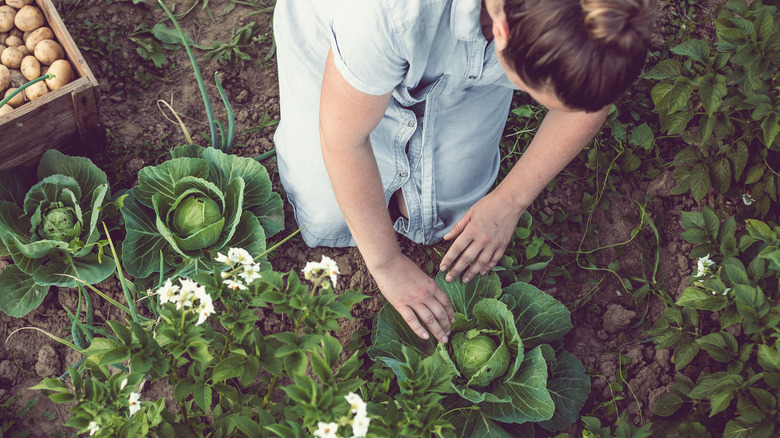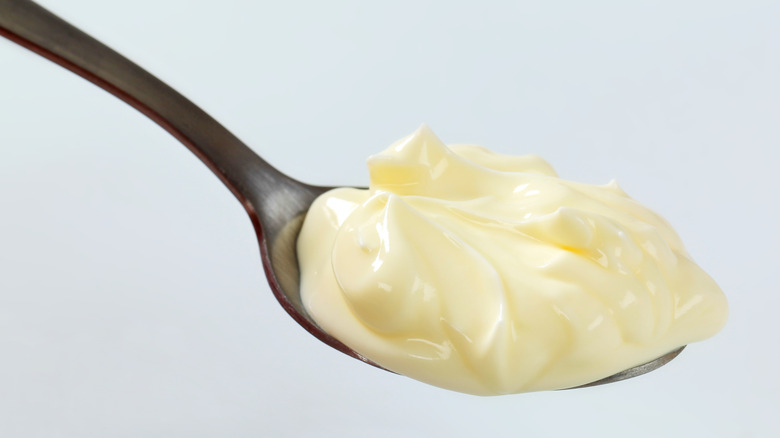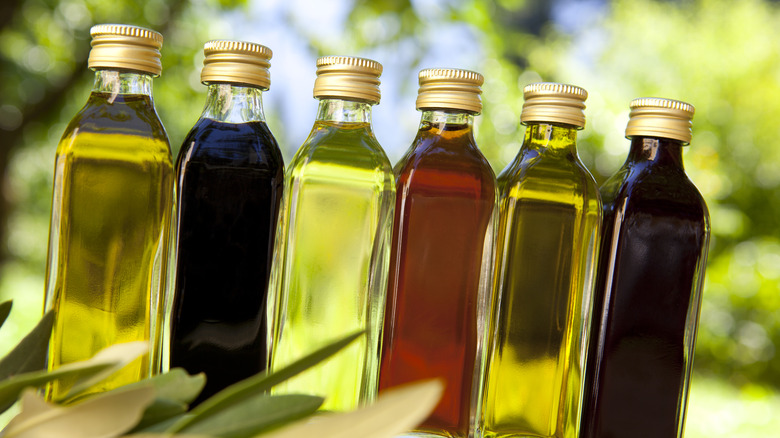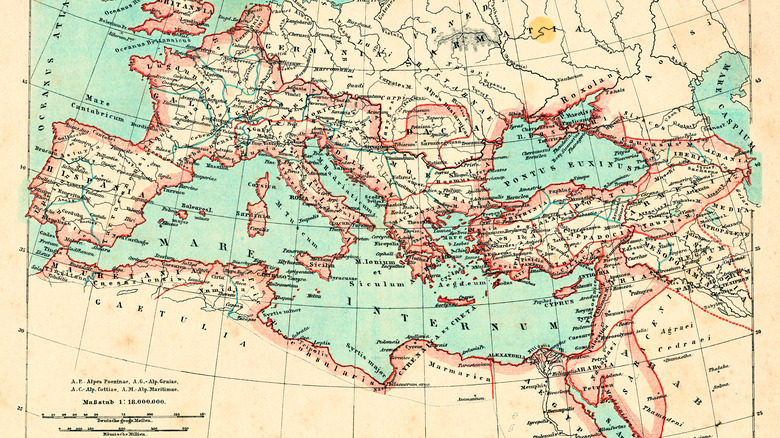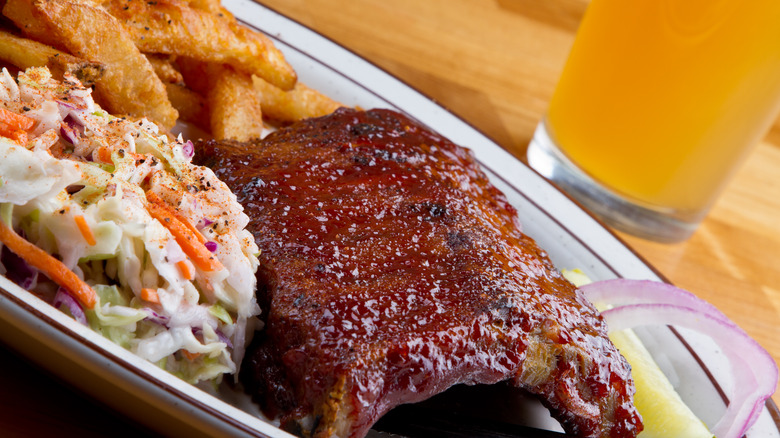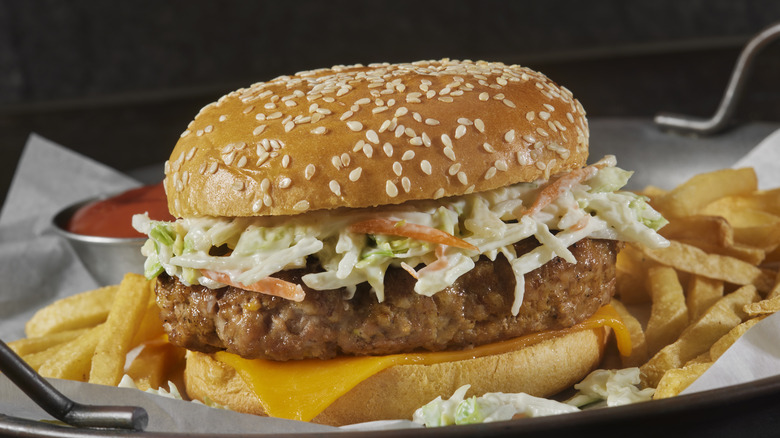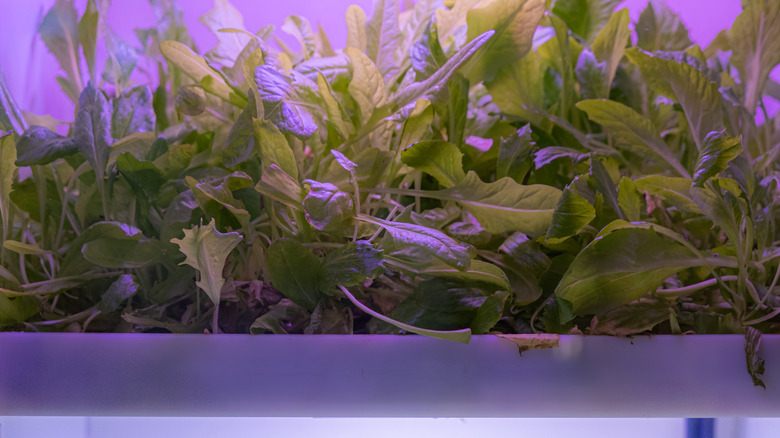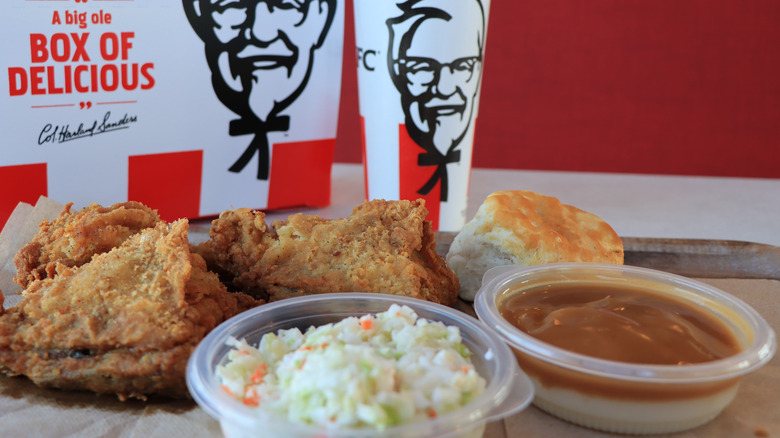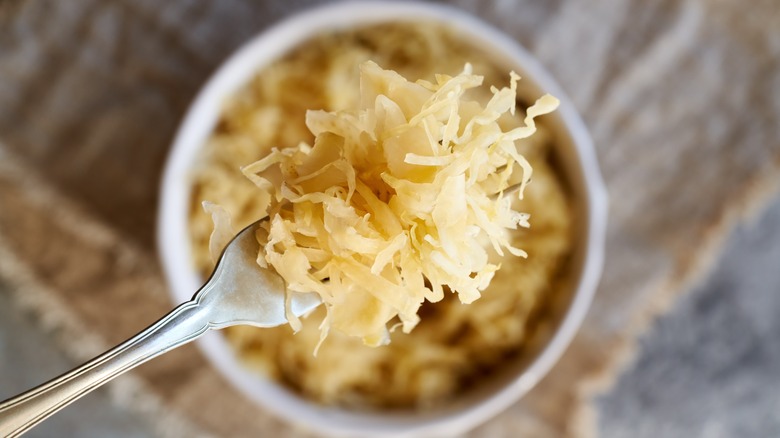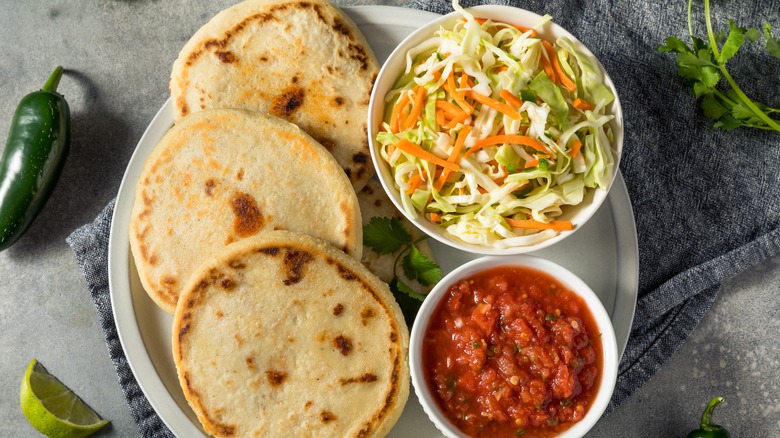The Complete History Of Coleslaw
If you close your eyes and imagine coleslaw, you probably have a pretty clear mental image. Your mental image, however, might vary from that of the person sitting right next to you. That is because cabbage is the only ingredient truly required to make a dish definable as coleslaw. Sure, there are some traditional recipes here in the United States, most of which include cabbage, carrots, mayo, and vinegar. And this salad of sorts is especially common as a barbeque accompaniment or sandwich topper. But the world of coleslaw expands beyond the mayonnaise-dressed side at your weekend cookout.
Coleslaw has a rich and ancient history that doesn't begin in the United States. The dish's main ingredient isn't even native to North America. So where does coleslaw come from? This dish's history goes back thousands of years and traverses thousands of miles across the globe. Keep reading to learn all about the complete history of coleslaw.
History of cabbage
Since cabbage is the one ingredient everyone agrees is necessary for coleslaw, let's start our dive into coleslaw's history by looking at the history of cabbage. Cabbages are part of the Brassica oleracea species and belong to the Capitata Group. The word "cabbage" itself comes from the French word "caboche," which means "head." Capitata, caboche — it all comes back to the fact that cabbages form what's called a "head." However, that's not the only way the plant's name hints at its origins. "Brassica" comes from the Celtic word for cabbage, "bresic."
Yes, that means that the Celts likely had much to do with introducing cabbage to the rest of Europe. Though the plant is likely native to the Mediterranean and Anatolia, the Celts who invaded that land in 600 B.C.E. probably brought the plant back with them when they headed into Northern and Western Europe.
Cabbage made its way eastward into Asia later, with Chinese cabbage discovered around the fifth century C.E.
History of mayonnaise
The true history of mayo isn't known and is, in fact, quite heated, as people cannot agree to the truth. One popular story is that it was invented in 1756 during the Seven Years' War. The tale goes like this: It happened after a battle between France and Spain at Port Mahon. When the French won, they didn't have any cream to make a sauce for a victory meal. So, their chef made an emulsion of egg and oil to create something new. Mayonnaise was named "mahonnaise" after the port city. However, it's also possible that this sauce already existed in the area of Mahon and Minorca.
In France, there's a city called Bayonne, and the people there also say that's where mayo started. The original name of the sauce was apparently "bayonnaise" and changed over time. But in the end, there's no record of mayonnaise in French cookbooks until 50 years later.
Because of when mayonnaise was invented, it couldn't have made its way into coleslaw until at least the 18th century. Even if mayonnaise is not an original coleslaw ingredient, it is certainly likely here to stay.
History of vinegar
Vinegar was used in the very first iterations of coleslaw. The condiment originated in 5,000 B.C.E. Babylon where it was used for culinary and medicinal purposes. It's also been used as a preservative since those times. Though the exact discovery of the product is unknown, a common theory is that someone forgot about some wine, and when they found it again, it was vinegar. It's been used as an antiseptic since sometime in the vicinity of 2,000 B.C.E.
Ancient Greeks used vinegar to pickle foods, and Romans even drank it. But not all vinegar is made from wine, though the English word is derived from the French for "sour wine." Vinegar can be made from any alcohol, and there are many types, each with its best use. If you're looking for a good vinegar for a simple coleslaw recipe, try apple cider vinegar. Made from double-fermented apple juice, this vinegar is less intense than white vinegar and is excellent in salads.
Roman origins
Coleslaw's ancestor is a Roman dish of cabbage, vinegar, eggs, and spices. It is attributed to Marcus Gavius Apicius in his cookbook. Apicius was a gourmand who lived during the first century C.E. A similar cabbage salad has made its way around the Internet thanks to the book, Roman Cookery by Mark Grant. However, the original recipe for what's called "Athenian cabbage" dates back to the fourth century B.C.E. and you can still find it online. According to Mnesitheus of Cyzicus, "Cabbage should be cut up with a very sharp iron knife, then washed and drained. A sufficient quantity of coriander and rue should be cut up together with cabbage; then sprinkle with honey and vinegar and add just a little bit of silphium. Incidentally, you can eat this as a meze."
Different translations put slightly different spins on the phrasing; it's also worth noting that "meze" very roughly translates to "snack," while rue is an aromatic shrub used as an herb native to the Balkans.
Dutch beginnings
A Dutch dish called koosla (cabbage salad) is the modern ancestor of today's American-style coleslaw. The Dutch were among the first European colonizers in what is now the United States. A recipe from 1770 in a book titled "The Sensible Cook: Dutch Foodways in the Old and New World" featured sliced cabbage, vinegar, oil, and melted butter. That was probably the first American coleslaw. Interestingly, when you Google search for "traditional Dutch coleslaw recipe" in Dutch today, the results are primarily variations of American coleslaw and KFC copycats.
Coleslaw isn't the only example of Dutch colonizers bringing their food with them to New York. When they arrived, they had their own seeds for most of the produce they'd eaten at home. Additionally, they brought their livestock over from the Netherlands. Bread was their staple food, though they added corn and squash — native to the Americas — into their diets.
In the United States
Cabbage and coleslaw have a long history in the United States. Cabbage did not come to North America until the mid-16th century when it was planted in Canada. Early European colonists likely grew it as well, and there is a written record of the vegetable from 1669. Coleslaw became popular when the Dutch settled in the Hudson River Valley; koosla became coleslaw, and American coleslaw has moved on from there, taking on many new forms.
There are now variations, including Lexington red coleslaw, which features ketchup and hot sauce. Or you can make American coleslaw with an Asian spin by adding ramen noodles for crunch or peanut sauce for delicious flavor. Nowadays, people even make "slaws." What's the difference between slaw and coleslaw? Slaws are coleslaw without the cabbage; they can use broccoli, jicama, carrots, or other veggies as the base. Basically, as long as they're shredded, they can be considered a slaw.
According to Tastewise, 2023 has seen coleslaw trends yet again changing. Aggregate data show that the most prominent diet associated with coleslaw these days is vegan, which means if people use mayo, it's not likely made of eggs. Moreover, people aren't as interested in coleslaw as they were in 2022 — social media conversations about the side dish have dropped by 61% between 2022 and 2023. That doesn't mean coleslaw is totally a thing of the past: 13% of restaurants have it on their menus.
Coleslaw festivals
Do you love coleslaw as much as we do? Then, you might want to take a trip to Fayetteville, Tennessee, to attend their annual Slawburger Festival. Every April since 2015, this town south of Nashville celebrates its mustard-based slaw on a burger. According to the city's website, "The festival has served as a way to share stories, create new memories, or revisit old ones from the past."
Some events at the festival involve the "Annual Always Endure Slawburger Chase" race, an ice-cream-eating contest, and live music. There is also a slaw-burger-eating contest that is considered the "tentpole" event of the festival. People even make their own coleslaw for a homemade slaw competition.
Not far away from the Slawburger Festival is the Hot Slaw Festival in Cleveland, Tennessee. The festival's site states that hot slaw is made with mustard, mayo, and a special sauce. However, it's described elsewhere as a vinegar and bacon-based warm dish. Regardless, you can enjoy hot slaw and local art if you head to this festival.
If you're a coleslaw fan, Tennessee is the place to be.
Cabbage ... in space
In 2017, astronauts on the International Space Station harvested a crop of Tokyo Bekana Chinese cabbage. This leafy green was chosen for the initiative known as the Veggie Project because it's tasty, nutritious, and widely available. One of the reasons the astronauts decided to farm in space was to see how crops get along with microgravity. They wanted to know if plant physiology changes in space. The astronauts ate some of the cabbage — the fifth plant grown at the ISS — as salad; some plants were sent back to NASA for testing.
NASA says its ISS veggie garden is as small as a carry-on luggage. The plants grow in "pillows" of clay and fertilizer. Because there's no gravity, the pillows help circulate the water, so the plants don't become waterlogged. On Earth, plants use gravity to orient themselves, but in space, they depend on light. In the future, NASA plans on expanding the plants astronauts grow at the space station.
KFC coleslaw myths
Do incarcerated people make KFC's coleslaw? Did the brand's coleslaw used to be green? Was Colonel Sanders really a colonel? There are so many myths and legends about this coleslaw-slinging chicken chain. To get the most obvious one out of the way, Colonel Sanders really was an honorary colonel who did serve in the military — so he was almost a real colonel.
But where is the truth? First, while we're not sure where the story about KFC using prison labor to specifically make its coleslaw got started, this is more like a stretching of the truth. According to the ACLU, KFC is just one of many corporations that purchased goods and services from Utah Correctional Industries in 2020. Were those specifically related to coleslaw? We just don't know.
As for green coleslaw, KFC Canada's coleslaw used to be green. Canadians were not pleased when the fried chicken chain changed its recipe in the Great White North back in 2017. So much so that KFC had to release a statement asking customers to give the new coleslaw a chance, saying they'd only changed the product due to customer demand. We have to attest to the coleslaw's popularity.
While KFC coleslaw is iconic, KFC isn't the only fast food restaurant that sells coleslaw. Chicken restaurants like Church's Chicken, Popeyes, and Raising Cane's all serve up this side.
Is sauerkraut coleslaw?
Since they're both side dishes made of shredded cabbage, it's not surprising people get sauerkraut and coleslaw confused. The most significant difference between the two is that sauerkraut is fermented, and most coleslaw is still raw once served. Like coleslaw, sauerkraut is incredibly easy to make at home. It just takes a bit more time as it requires that fermentation process. Depending on how you prepare them, there can be significant nutritional differences. Coleslaw has much higher levels of vitamin K — however, it is also higher in fat if made with mayonnaise. Besides being lower in fat, both monounsaturated and polyunsaturated sauerkraut has higher levels of iron and copper.
Sauerkraut also has a unique, rich history. While sauerkraut is traditionally considered a German food, its history can be traced back to ancient China, where people first fermented cabbage 2,000 years ago. Europeans didn't start fermenting cabbage until the 1500s. When Germans began settling in the U.S. in the 1800s, they brought sauerkraut, which soon became an American favorite.
Coleslaw around the world
Many countries have their own versions of coleslaw, from the Lebanese salatet malfouf to the Salvadoran curtido to the Italian insalata capricciosa. For example, El Salvador's famous pupusa accompaniment, curtido is more about the cooking method than the ingredients. Europeans brought cabbage, in addition to death and disease, when they arrived in South America. At that point, cabbage became an integral part of curtido.
In the Middle East, people also eat vinegar-based cabbage salads, which makes sense considering the dish originated in the Roman and Greek eras. In Lebanon, there's salatet — or salad — malfouf flavored with dill, mint, and parsley. In Vietnam, you'll find gỏi gà bắp cải, a chicken and cabbage salad. And Russians serve kapusta provansal, a cabbage salad with grapes and apples. These are just a few examples of how the world eats coleslaw in many different permutations.
What's for sure is that cabbage has gone from its humble beginnings to becoming a worldwide phenomenon, and coleslaw has made its way to the spotlight along with it.
